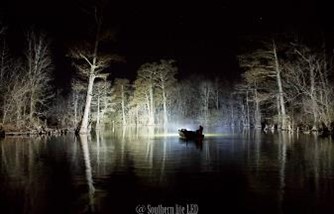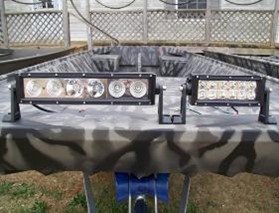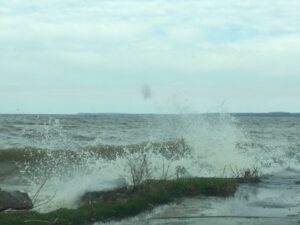Life Jackets, Lights, Firearms
An article from WWA’s Words From The Wardens.
This article originally appeared in Wisconsin Waterfowl Association’s September, 2022 eNewsletter.
 By DNR Boating Law Administrator Warden Darren Kuhn
By DNR Boating Law Administrator Warden Darren Kuhn
Waterfowl season is right around the corner. That means it is time for important annual preparation duties.
For many of us, it can mean stocking up on shells and pulling the camouflage out of the closet. It can also mean scheduling trips to check the conditions at marshes, sloughs and other favorite waterfowl hunting spots.
Usually, when I write about the pre-season and early-season waterfowl hunting seasons, I talk about the importance of wearing your life jackets and having the proper boat lights on the duck boats. This year is no different.
 WEAR THE LIFE JACKET: HUNTER SAFETY DEPENDS ON IT
WEAR THE LIFE JACKET: HUNTER SAFETY DEPENDS ON IT
Life jackets are essential. It’s also the law, and it’s also for your safety.
State and federal boating laws require that one wearable-type life jacket of the proper size be readily accessible for each person on board a boat. The life jacket must be ready to use quickly in an emergency. It doesn’t include having the life jacket stowed in a compartment buried under all the decoys and other gear in the boat.
HEAVIER HUNTING CLOTHES A FACTOR IN WATER SAFETY
I would ask boaters and hunters alike to take this requirement a step further by wearing their life jackets. Hunters generally wear heavier clothes than the average summer recreational boater due to the cooling weather. Hunters also often wear their waders out to their spots. Both factors increase the dangers and risk of drowning in the event of a boating incident. Wearing a life jacket reduces this risk significantly.
Wisconsin has had boating fatalities this boating season where people voluntarily jumped into the water and never surfaced. Unfortunately, these people were not wearing their life jackets and lost their lives. While jumping into the water isn’t a common activity for a waterfowl hunter, if a hunter wearing bulky clothing and/or waders ends up in the water without a life jacket, it could lead to tragedy. Please wear your life jacket.
 REQUIRED BOAT NAVIGATION LIGHTS: TELLS OTHER OPERATORS YOUR ROUTE
REQUIRED BOAT NAVIGATION LIGHTS: TELLS OTHER OPERATORS YOUR ROUTE
Boat lights are another requirement.
- Here’s the law: red and green navigation lights on the bow of the boat and a white light visible for 360° at the stern of the boat are required for all motorboats operating between sunset and sunrise.
- A white light is to avoid a collision and is required of paddle craft as hunters go to their spots before sunrise and return to the landing after sunset. It’s a common occurrence to install aftermarket white LED light bars on the bow of hunting boats.
 Hunters need to know any lights that detract from the required navigation lights are illegal. Boat lights are not designed to aid the operator in seeing at night. Boat lights are to indicate the direction of travel for other boaters to see and be able to adhere to the rules of the road.
Hunters need to know any lights that detract from the required navigation lights are illegal. Boat lights are not designed to aid the operator in seeing at night. Boat lights are to indicate the direction of travel for other boaters to see and be able to adhere to the rules of the road.
An occasional blip of a spotlight can be used to avoid a collision or to get into your hunting spot. However, a constant light that takes away from the effectiveness of the required navigation lights is not allowed.
The red/green and white lights each have specific meanings – to show other boats on the water who is the give-way vessel and who is the stand-on vessel. The lights help direct who has the right of way.
Anyone who has hunted an opener or after the northern mallards have started moving south knows the boat landings are full. There are a lot of hunting boats heading out, not to mention the fall anglers hitting the morning bite. Boat lights need to be used – and used appropriately – to keep everyone safe on the water.
WEATHER IS ALWAYS A SAFETY FACTOR

Photo taken by Darren Kuhn at Bayshore County Park, Brown County. 10/21/21
Please keep an eye on the weather forecast and current weather conditions. In a lot of situations, hunters travel long distances to experience a new hunt or for the annual hunting trip. When people travel these distances, there is the feeling that the hunt must happen no matter the weather. However, hunters need to respect the weather. Bad weather creates a significant safety concern in the typically smaller, less stable hunting boats.
Every season, DNR conservation wardens and area first responders are called to rescue hunters who ventured out in unsafe weather conditions and are caught in treacherous conditions. Plan your hunt and make checking the weather forecast part of that plan. There isn’t a duck on the horizon that’s worth risking your life. If you get to the landing and the waves are crashing over the break wall, think about the safety implications before you head out. You don’t want to end up in a situation where you need to get rescued or worse.
FIREARMS: UNLOADED WHEN MOTOR IS RUNNING
Another topic I want to touch on is firearms safety.
While the law doesn’t require your shotguns to be cased when in the boat, it does require the shotgun to be unloaded anytime the motor is running. This includes while traveling to and from your hunting spot or going to pick up a crippled bird.
Having a loaded shotgun in a boat is a major concern and is just asking for problems. Whether it’s a dog pacing back and forth or navigating waves, the safety can easily get switched, making a catastrophe just one wave away.
Discharging a shotgun from a moving boat or even a boat still making way with a motor in neutral is unsafe and illegal. These are unstable platforms, and it’s not appropriate or legal to shoot from a boat.
Safe shooting zones in a boat or a blind are a must. These are tight quarters with limited shooting zones for each person in the boat or blind. These zones need to be honored. Crossing into another’s zone risks unintentionally shooting your hunting companion. While this is tragic and doesn’t happen often, it does happen enough to be worth mentioning.
Remember your firearms safety rules:
- Treat every firearm as if it is loaded
- Always point the muzzle in a safe direction
- Be sure of your target and what’s beyond
- Keep your finger off the trigger until you’re ready to fire
Following these boating and hunting safety tips can lead to a safe and enjoyable waterfowl hunt. Good luck this season.
